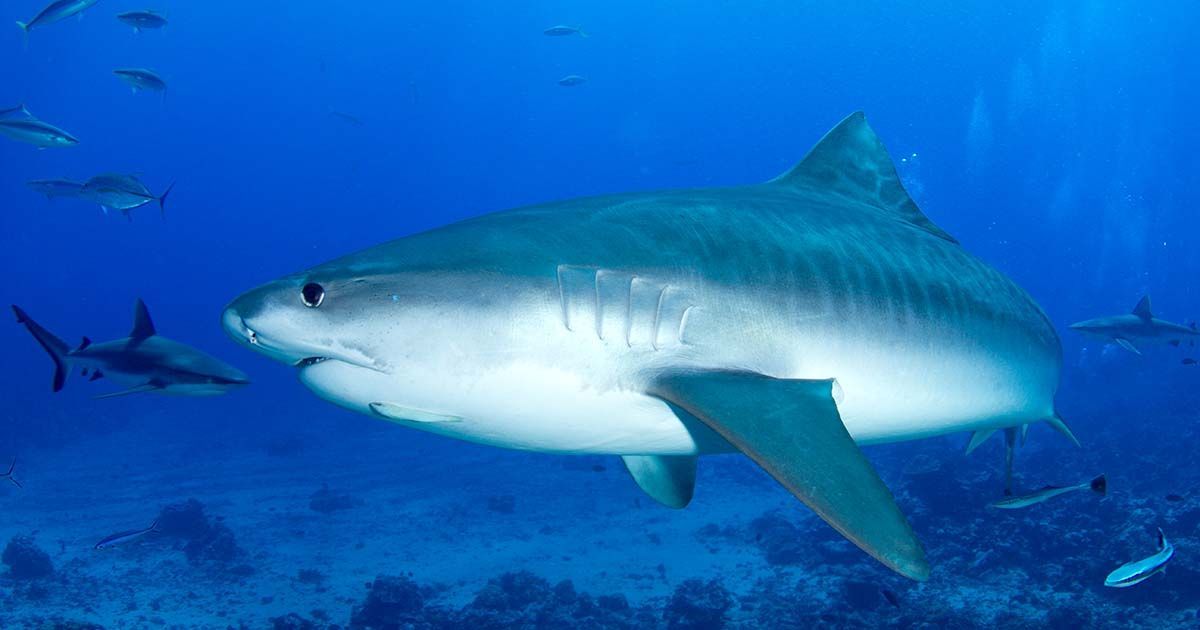17 Essential Hawaii Shark Facts That Locals Want You to Know (2025 Update)
Understanding Sharks in Hawaiian Waters
Hawai'i's crystal-clear waters are home to a diverse array of marine life, including over 40 species of sharks. While encountering a shark may evoke fear, understanding these creatures' behaviors can transform apprehension into appreciation. This comprehensive guide offers updated insights into
Hawaii's shark population, safety tips, and cultural significance, ensuring you're well-informed for your next island adventure.
Table of Contents - 17 Essential Shark Facts:
- Are There Sharks in Hawaii?
- Common Shark Species in Hawaiian Waters
- Shark Attack Statistics in Hawaii
- Understanding Shark Behavior
- Cultural Significance of Sharks in Hawaii
- Shark Safety Tips for Swimmers and Snorkelers
- Shark Sightings and Warning Systems
- Shark Diving and Eco-Tourism in Hawaii
- Conservation Efforts and Shark Protection
- Debunking Common Shark Myths
- When Are Sharks Most Active in Hawaii?
- Brackish Water and Shark Activity
- Shark Senses: How They Detect You
- What to do if You Encounter a Shark
- Local Knowledge: Tips from Hawaiian Snorkelers
- Ethical Shark Tourism: What to Look For
- The Future of Sharks in Hawaiian Waters
- FAQs

1. Are There Sharks in Hawaii?
Yes, sharks are an integral part of Hawaii's marine ecosystem. From the shallow reefs near the shoreline to the deep pelagic zones offshore, these apex predators help keep ocean populations healthy by preying on the weak and sick, maintaining balance within the food chain.
Local communities, lifeguards, and ocean safety officials monitor shark activity, and many beach areas post signs if a sighting occurs. It's always a good idea to stay informed, avoid murky water, don't swim near fishing boats, and steer clear of swimming alone at dawn or dusk—when sharks are more active.
Overall, sharks in Hawaii are not just residents of the ocean; they're part of a profound cultural respect rooted in Native Hawaiian traditions, where certain sharks are considered 'aumakua (spiritual guardians). Awareness, not fear, is the best way to coexist safely and respectfully with these magnificent creatures
2. Common Shark Species in Hawaiian Waters
Several shark species are commonly found around the Hawaiian Islands, each essential in maintaining the balance of Hawaii's unique marine ecosystem. While some are more elusive than others, divers, snorkelers, and boaters regularly spot a few species.
- Whitetip Reef Shark (Triaenodon obesus): These small, slender sharks are often seen resting motionless in caves or under ledges during the day—a behavior rare among most sharks. Whitetips are nocturnal hunters, coming alive at night to feed on reef fish, crustaceans, and octopuses. They're non-aggressive and pose little threat to humans.
- Blacktip Reef Shark (Carcharhinus melanopterus): Easily identifiable by the dark black tips on its dorsal and caudal fins, this species is often spotted in shallow coral reef areas. Their shy and skittish nature briefs close encounters, though they are one of the most common sharks encountered by snorkelers and beachgoers.
- Sandbar Shark (Carcharhinus plumbeus): Recognized for its tall dorsal fin and streamlined body, the sandbar shark prefers deeper coastal waters and avoids coral reefs. Despite their intimidating appearance, sandbar sharks are not aggressive and rarely interact with humans.
- Scalloped Hammerhead Shark (Sphyrna lewini): These distinctive sharks with their "hammer"-shaped heads are often seen in schools, especially around island drop-offs and channels. The species gather in large numbers near Kaneohin Hawaii e Bay and other nursery areas. Their wide-set eyes and electroreceptive capabilities make them skilled hunters.
- Tiger Shark (Galeocerdo cuvier): As one of the largest shark species in Hawaii, the tiger shark can grow over 16 feet long. Named for the dark vertical stripes along its body, this species is a solitary hunter known to consume various prey—from fish and sea turtles to seabirds. While tiger sharks are involved in most of Hawaii's rare shark incidents, they are still not considered a common threat, and attacks are statistically improbable.
3. Shark Attack Statistics in Hawaii
Shark attacks in Hawaii are exceedingly rare. According to the Hawaii Department of Land and Natural Resources, the average number of shark incidents per year is approximately 5.8. Most encounters are non-fatal and often involve surfers or swimmers in deeper waters.
4. Understanding Shark Behavior
Sharks often get a bad rap due to how they're portrayed in movies, but these creatures are more curious than aggressive in Hawaiian waters. Their actions are guided by instinct and environmental cues—not a desire to attack humans.
Curious, Not Dangerous
Sharks are naturally curious and may investigate unfamiliar sights or sounds. However, they typically avoid humans. Bites are extremely rare and usually a case of mistaken identity, like a surfer being mistaken for a seal.
How Sharks Sense Their Surroundings
Sharks use a range of highly developed senses to navigate and hunt:
- Smell: Can detect trace amounts of blood.
- Ampullae of Lorenzini: Detect electrical impulses from living things.
- Vision: Excellent low-light sight.
- Hearing: Can pick up low-frequency sounds from afar.
What Attracts Sharks?
Specific actions and items can catch a shark's attention:
- Splashing or sudden movements
- Shiny or reflective objects
- Swimming during low-light hours (dawn or dusk)
Ocean experts advise staying calm and moving deliberately in the water.
Reef Sharks Near Shore
The sharks commonly seen near Hawaii's shorelines are smaller reef species with little to no threat. Lifeguards and marine biologists often note their peaceful presence.
Respect, Don't Fear
Sharks play a vital role in ocean ecosystems. Instead of fearing them, we should approach them with respect and informed awareness.
5. Cultural Significance of Sharks in Hawaii
In Hawai'i, sharks—called manō—are deeply respected and play a meaningful role in the islands' culture and spirituality. Far from being feared, sharks are honored as powerful guardians, protectors, and symbols of ancestral connection.
Manō as 'Aumākua: Ancestral Guardians
For many Hawaiian families, a shark may serve as an 'aumākua—a personal or family guardian spirit. These sacred beings are believed to watch over their descendants, guiding and protecting them from harm.
Stories passed down through generations tell of sharks rescuing lost fishermen, warning of storms, and defending family members. As a sign of reverence, families may offer prayers, chants, or even food to their manō 'aumākua—and avoid harming or eating sharks altogether.
Legends of Protection: Ka'ahupahau and Shark-Men
One of the most well-known shark legends is that of Ka'ahupahau, a shark goddess who protected the waters of Pu'uloa (Pearl Harbor) from aggressive sharks. She was revered for ensuring safe passage for locals.
Other Hawaiian legends speak of shark-men—part human, part shark—who lived among people and could return to the sea at will, symbolizing the deep ties between the ocean and Hawaiian identity.
Sharks in Hawaiian Tradition
Sharks appear in many aspects of Hawaiian tradition:
- Oli (chants) and hula honor their strength and spirit
- Petroglyphs depict their form and symbolism
- Chiefs (ali'i) often saw the manō as a sign of power, wisdom, and authority
These traditions reflect a culture that respects the ocean and its creatures.
A Legacy of Respect and Stewardship
Today, this cultural perspective shapes modern attitudes and conservation efforts in Hawai'i. Rather than being feared, sharks are valued as essential to both the marine ecosystem and cultural heritage. Education and protective policies help foster a sense of coexistence and stewardship.
By understanding their cultural role, both locals and visitors can view sharks not as threats but as symbols of strength, guidance, and ancestral legacy. This respect enriches the connection to Hawai'i's natural world and traditions.
6. Shark Safety Tips for Swimmers and Snorkelers
To minimize the risk of shark encounters, follow these tips.
- Avoid swimming alone: Sharks are more likely to approach solitary individuals.
- Stay out of the water at dawn and dusk: These are peak feeding times for many shark species.
- Avoid murky waters: Reduced visibility increases the chance of mistaken identity.
- If bleeding, do not enter the water: Sharks can detect blood from significant distances.
- Avoid wearing shiny jewelry: Reflections can resemble fish scales. Following these guidelines can significantly reduce the likelihood of an encounter.
7. Shark Sightings and Warning Systems
Hawaii has implemented warning systems to inform beachgoers of shark sightings. Signs are posted on beaches where sharks have been spotted, advising caution or temporary closure of the area. Always heed these warnings and consult local authorities or lifeguards for updates.
8. Shark Diving and Eco-Tourism in Hawaii
For those interested in observing sharks safely, Hawaii offers several eco-tourism opportunities.
- Cage-Free Shark Diving: Experience sharks in their natural habitat under the guidance of experienced professionals.
- Educational Tours: Learn about shark behavior, conservation efforts, and the importance of sharks in the marine ecosystem. These tours promote awareness and respect for sharks while ensuring participant safety.
9. Conservation Efforts and Shark Protection
Hawaii has taken significant steps to protect shark populations.
- Legal Protections: Laws prohibit the killing or harming of sharks in state waters.
- Research and Monitoring: Ongoing studies track shark movements and behaviors to inform conservation strategies.
- Public Education: Programs aim to dispel myths and promote understanding sharks' ecological roles. These efforts contribute to the preservation of marine biodiversity and the health of ocean ecosystems.
10. Debunking Common Shark Myths
Several misconceptions about sharks persist.
- Myth: All sharks are dangerous to humans.
- Fact: Only a few species have been involved in incidents with humans.
- Myth: Sharks are mindless killers.
- Fact: Sharks are intelligent predators with complex behaviors.
- Myth: Shark attacks are common.
- Fact: Shark attacks are extremely rare, especially compared to other risks. Understanding the truth about sharks helps foster a more balanced perspective.
11. When Are Sharks Most Active in Hawaii?
Sharks are a year-round presence in Hawaiian waters, but their activity levels vary depending on the time of day, season, and environmental conditions.
Peak Activity Times: Dawn and Dusk
Sharks are crepuscular feeders, meaning they are most active during dawn and dusk—prime feeding times when visibility is low and bait fish are more abundant. Ocean safety experts recommend avoiding the water during these periods to reduce the risk of a shark encounter.
Midday Incidents: Correlation with Human Activity
Interestingly, most shark incidents occur between 10:00 AM and 4:00 PM—when the ocean is busiest with swimmers and surfers. This doesn't necessarily reflect shark behavior but human presence in the water.
Seasonal Patterns and Breeding Behavior
Shark activity can also increase due to mating and pupping cycles. For example, tiger sharks near Maui are more active in the fall, likely due to females coming closer to shore to give birth.
Safety Tip
To stay safe, avoid swimming in murky water, near schools of fish, or during low-light times when sharks are naturally more active.
12. Brackish Water and Shark Activity
Brackish water—where freshwater streams mix with ocean water—creates ideal conditions for prey fish, attracting sharks. This is particularly relevant in river mouths and after heavy rainfall. Visibility in brackish waters is low, which increases the risk of accidental shark bites.
Avoid swimming in these areas, especially when the water appears muddy or cloudy. A 2013 University of Hawai'i study showed a clear correlation between murky water and increased shark incidents, further emphasizing the importance of water clarity in determining risk levels.
13. Shark Senses: How They Detect You
Sharks are incredibly well-equipped predators, evolved over hundreds of millions of years to master their ocean environment. Their sensory systems are among the most sophisticated in the animal kingdom, allowing them to detect even the slightest changes in their surroundings.
Understanding how sharks perceive the world helps explain their behavior—and why they sometimes investigate unfamiliar objects or swimmers in the water.
Electroreception – Ampullae of Lorenzini
One of the most fascinating abilities sharks possess is electroreception. Sharks can detect the weak electrical fields generated by all living animals by using tiny gel-filled pores around their snout called ampullae of Lorenzini.
These sensors are so precise that a shark can sense the heartbeat of a nearby fish—even if it's hiding beneath the sand. This ability is most useful in close-range hunting and contributes to a shark's curiosity when encountering unfamiliar shapes or movements, like a swimmer or surfboard.
Lateral Line System
The lateral line system runs along the sides of a shark's body, a network of fluid-filled canals that detect water displacement. This system acts like a sixth sense, allowing sharks to "feel" vibrations in the water, such as a struggling fish or the repetitive splash of human swimming. It helps them zero in on prey even in complete darkness or murky conditions.
Keen Sense of Smell
The myth about sharks detecting a single drop of blood in an Olympic-sized pool isn't far off. Some species can smell blood concentrations as low as one part per 10 billion.
Their olfactory bulbs—located in front of the brain—are large and highly sensitive, enabling them to detect chemical cues like blood, bodily fluids, or fish oils from long distances. Sh sharks don't immediately become aggressive when they detect blood; it piques their interest, prompting them to investigate further.
Vision
While sharks were once thought to have poor eyesight, research shows that many species have excellent vision, especially in dim lighting. Their eyes are adapted to low-light environments like deep or murky waters, and they can see contrasts and movement well. However, sharks rely less on sight than other senses during hunting or exploration.
Hearing
Sharks can hear low-frequency sounds (between 20 and 1,000 Hz) from several hundred feet away. They are susceptible to irregular, pulsing sounds, like those made by wounded or panicking prey. This is why splashing or erratic movements in the water may draw a shark's attention—they mimic the sounds of injured fish.
Why This Matters
By understanding how sharks interpret their surroundings, ocean-goers can take practical steps to reduce the chances of a curious shark encounter.
Avoid excessive splashing, especially in low-visibility waters, and don't wear shiny jewelry that might mimic the glint of fish scales. Respecting a shark's sensory world goes a long way in fostering safe and peaceful coexistence in Hawaiian waters.
14. What to Do If You Encounter a Shark
While encounters are rare, knowing how to react is crucial:
- Stay calm and maintain eye contact.
- Do not splash or make erratic movements.
- Back away slowly toward the shore or your boat.
- If the shark gets too close, use any object (camera, snorkel, surfboard) to create a barrier.
- Fighting back should be your last resort, aimed at sensitive areas like the gills, nose, or eyes.
15. Local Knowledge: Tips from Hawaiian Snorkelers
Many local snorkelers and divers use subtle clues to gauge shark presence:
- Frozen Reef Fish: Reef fish stay still when a predator is near. This unusual behavior can indicate that a shark is in the vicinity.
- Absence of Turtles or Seals: When these animals disappear, it could mean a large predator is nearby.
- Presence of Birds Diving: Indicates baitfish below, which could attract sharks.
These real-life cues aren't found in guidebooks but are invaluable to locals and seasoned swimmers.
16. Ethical Shark Tourism: What to Look For
As shark tourism becomes more popular in Hawaii, it's important to support ethical operators:
- Choose tours that follow safety and conservation guidelines.
- Avoid businesses that bait sharks or operate in ecologically sensitive areas.
- Look for companies involved in research or public education.
Organizations like One Ocean Diving and Hawaii Shark Encounters prioritize ethical interactions and contribute to marine conservation initiatives.
17. The Future of Sharks in Hawaiian Waters
Climate change, overfishing, and pollution pose increasing threats to Hawaii's shark populations. Fortunately, ongoing conservation efforts and a growing public awareness campaign aim to reverse this trend.
Key developments include:
- Bans on shark finning and trade.
- Designated marine sanctuaries and protected areas.
- Community-driven reef restoration projects.
With local, tourist, and lawmakers' support, Hawaii is poised to lead the way in shark conservation and marine stewardship.
Frequently Asked Questions (FAQs):
How likely is a shark attack in Hawaii?
Extremely unlikely. Your odds are approximately 1 in 11.5 million. You're more likely to be injured by a dog, a lightning strike, or a vending machine.
Are there great white sharks in Hawaii?
Great whites are extremely rare in Hawaiian waters. They prefer colder, coastal waters. Hawaii's shark population mainly includes tiger, hammerhead, and reef sharks.
Can you swim with sharks in Hawaii?
Yes! Several companies offer safe, ethical, cage-free shark diving experiences primarily off Oahu's North Shore.
What color swimsuits should I avoid?
Bright, high-contrast colors like yellow, orange, and white can attract sharks. Opt for dark or neutral tones.
What's the most dangerous shark in Hawaii?
Tiger sharks are the most potentially dangerous due to their size and curiosity. However, fatal encounters are exceedingly rare.
Do dolphins keep sharks away?
Not necessarily. While dolphins and sharks may share habitats, the presence of dolphins doesn't guarantee the absence of sharks.










